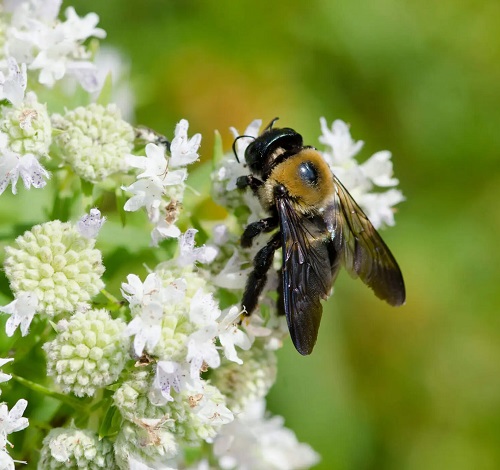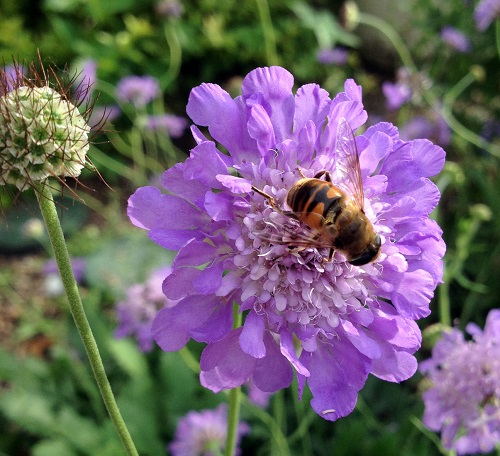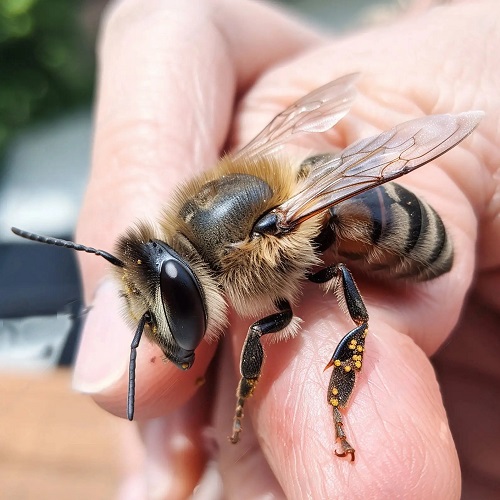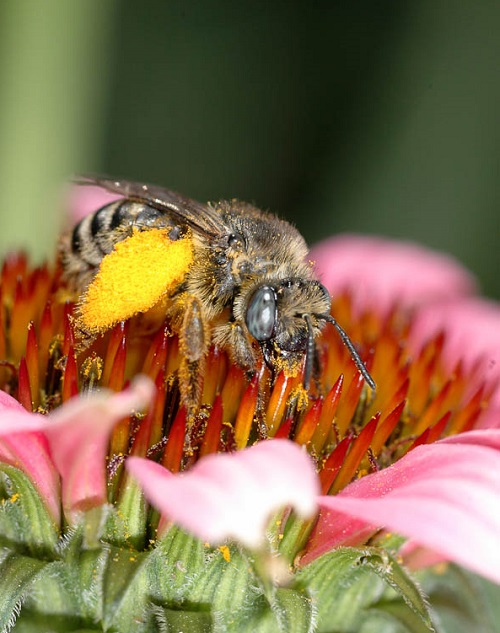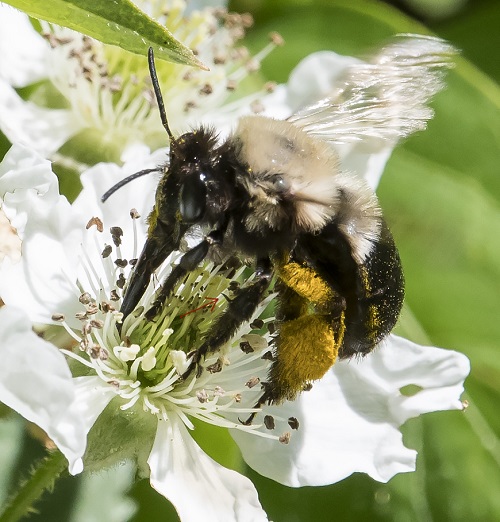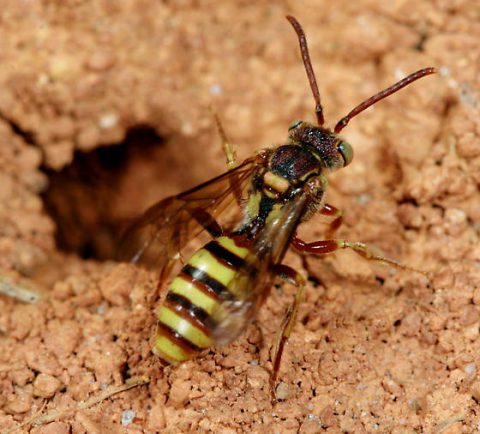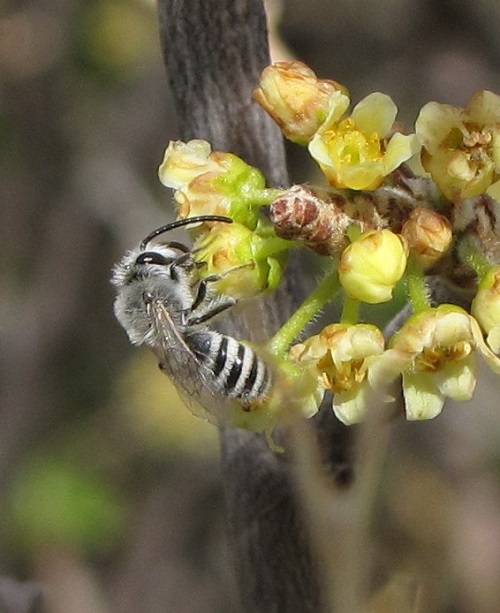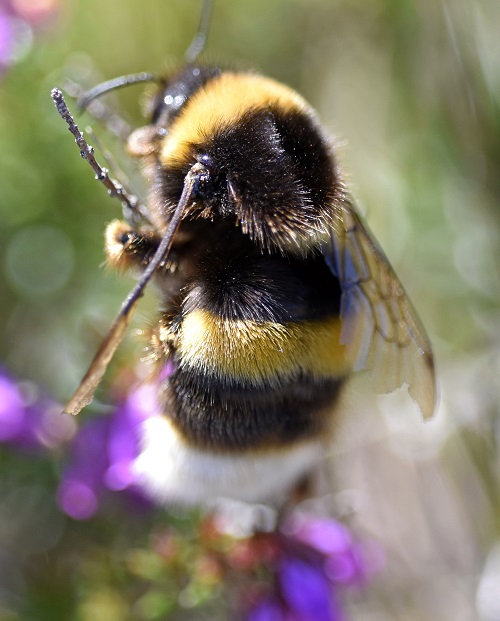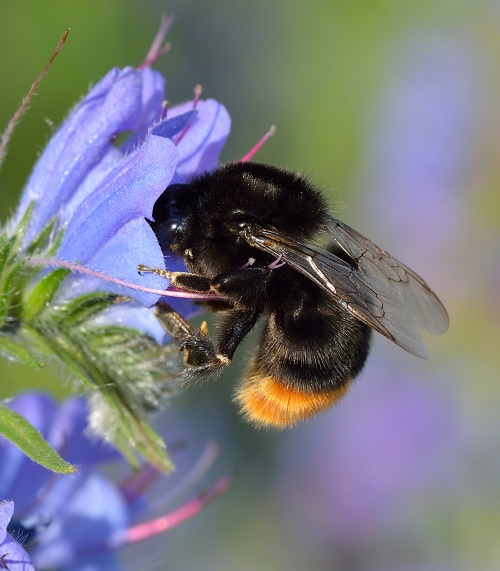Do you know about the Different Types of Bees that you spot buzzing around in your garden? Well, we have them all for you!

From the solitary mason bees, master architects of the insect world, to the vibrant bumblebees, vital for pollinating specific flowers, understanding the Different Types of Bees can transform how we view our gardens. Let’s have a look at them in detail!
Find What Does it Mean When a Bee Lands on You here
What Makes Types of Bees Important to Our Lives?
Bees, including honeybees and various native species, are critical pollinators that facilitate the reproduction of various plants, including fruits, vegetables, and nuts.
Beyond food, bees have cultural, economic, and environmental value, playing a vital role in maintaining biodiversity, ecosystem, and health and even offering insights into scientific research. Their presence enriches our lives in countless ways, making their protection and conservation a matter of utmost importance for our well-being and the health of our planet.
Here are the plants that attract bees
What are the Different Types of Bee Families?
Apidae Family
The Apidae family is the largest bee family. It has over 5,700 bee species! They are social bees, meaning they live together and work as a team to build their homes. Some examples are:
a. Honeybees (Apis mellifera)
b. Bumblebees (Bombus spp.)
c. Stingless Bees (Meliponini)
Halictidae Family
The Halictidae family houses sweat bees. These bees are small and shiny, and they can be found all around the world. Some sweat bees live alone, while others form a hive. Popular Halictidae bees are:
a. Sweat Bees (Halictus spp.)
b. Metallic Sweat Bees (Agapostemon spp.)
c. Green Sweat Bees (Augochlora spp.)
Megachilidae Family
With over 4,000 species, Megachilidae uses materials like flower petals, mud, and leaves to build their nests. They are like architects, crafting their homes in different ways. Common ones include:
a. Mason Bees (Osmia spp.)
b. Leafcutter Bees (Megachile spp.)
c. Carder Bees (Anthidium spp.)
Andrenidae Family
Meet the mining bees from the Andrenidae family! They are early risers, buzzing around in the springtime. They have a tiny sting, and they prefer to live alone. Prominent examples of Andrenidae bees are:
a. Mining Bees (Andrena spp.)
b. Ashy Mining Bees (Andrena cineraria)
c. Carpenter Bees (Xylocopa spp.)
You can check the yellow butterfly spiritual meaning here
Colletidae Family
The Colletidae family has unique members like plasterers, miners, and masked bees. They are spread across the world, but most of them are found in South America and Australia. Here are some examples:
a. Plasterer Bees (Colletes spp.)
b. Masked Bees (Hylaeus spp.)
c. Resin Bees (Hylaeus spp.)
Melittidae Family
The Melittidae family is a small but special group with 201 species. These bees are solo flyers, building their nests in the ground. They are commonly found in dry parts of southern Africa. These include:
a. Digger Bees (Melitta spp.)
b. Blunt-tailed Bees (Macropis spp.)
c. Long-faced Bees (Macropis spp.)
Stenotritidae Family
Stenotritidae, a bee family exclusive to Australia, comprises only 21 species in two genera, Ctenocolletes and Stenotritus, making it the smallest among recognized types of bee families. You might spot the following Stenotritidae bees easily:
a. Ctenocolletes Bees (Ctenocolletes spp.)
b. Stenotritus Bees (Stenotritus spp.)
Different Types of Bees Everyone Should Know About
1. Honeybee
Scientific Name: Apis mellifera
Appearance: Honeybees are usually golden-yellow and have black bands on their abdomen.
Natural Habitat: Found in meadows, gardens, and orchards.
Sting: Mild for most people and pets, causing temporary pain and swelling.
Honeybees are known for making sweet honey! They live in hives and work together as a team.
2. Bumblebee
Scientific Name: Bombus pensylvanicus
Appearance: Bumblebees are big and fuzzy, often black and yellow.
Natural Habitat: They live in various places like gardens, fields, tree groves, and forests.
Sting: This can be painful but is usually not dangerous unless the person or pet stung has an allergy.
Bumblebees are chubby, cute, and friendly. They are excellent pollinators, helping plants grow new seeds and fruits.
Find Do Bumble Bees Sting?
3. Carpenter Bee
Scientific Name: Xylocopa pubescens
Appearance: Carpenter bees are quite large and have a shiny, black abdomen.
Natural Habitat: They are often found near wooden structures and gardens.
Sting: Can cause mild pain, redness, and swelling. Not fatal or toxic.
Carpenter bees are good at making holes in wood to build their nests. Despite their name, they rarely damage homes. They are important pollinators, too.
Check out this post and find out do carpenter bees sting
4. Mason Bee
Scientific Name: Osmia spp.
Appearance: Mason bees are small and often metallic blue or black.
Natural Habitat: They’re found in gardens and parks.
Sting: Mason bee stings are not harmful to humans or pets.
Mason bees are excellent builders. They use mud to create nests in tiny spaces. These bees are fantastic helpers for fruit trees and spring flowers.
5. Leafcutter Bee
Scientific Name: Megachile spp.
Appearance: Leafcutter bees are medium-sized with black bodies and pale bands on their abdomen.
Natural Habitat: You can find them in parks and fields.
Sting: Leafcutter bee stings are rare and cause no harm to humans or pets.
Leafcutter bees are amazing leaf artists. They cut perfect circles from leaves to create cozy nests.
6. Mining Bee
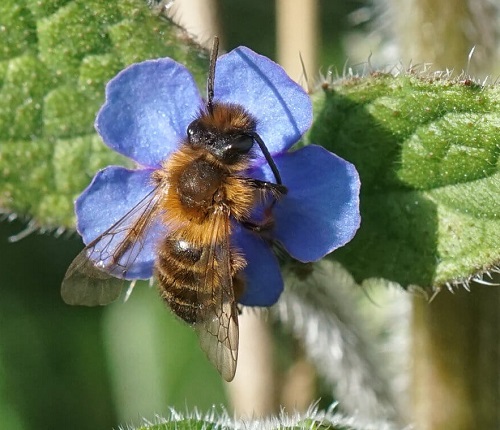
Scientific Name: Andrena fulva
Appearance: Mining bees are small and often have hairy bodies, ranging in colors from black to brown.
Natural Habitat: Found in meadows and sandy areas.
Sting: Do not harm humans or pets. Stings are rare and mild.
Mining bees are gentle and often solitary bees. They dig tunnels in the ground to make their homes. Just like other bees, they play a vital role in helping flowers reproduce by moving pollen around.
7. Sweat Bee
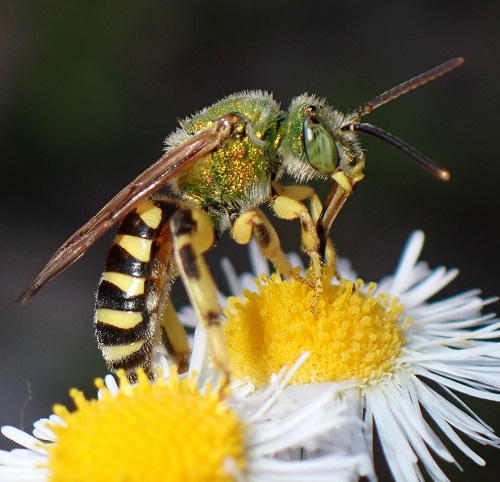
Scientific Name: Halictidae spp.
Appearance: Sweat bees are tiny and can be black, brown, or metallic green.
Natural Habitat: You’ll stumble upon these in gardens and woodlands.
Sting: Not harmful to humans or pets.
Sweat bees are small but essential bee types. They might land on you because they are attracted to sweat! Despite their name, they are harmless.
Discover the purple butterfly meaning here
8. Longhorned Bee
Scientific Name: Eucera spp.
Appearance: Longhorned bees are medium-sized with long antennae and often have brown or black bodies.
Natural Habitat: Often seen near gardens and forests.
Sting: Stings are not toxic and only cause discomfort to people and pets.
Longhorned bees are excellent pollinators for plants with deep flowers. Their long antennae help them navigate and find nectar.
9. Digger Bee
Scientific Name: Anthophorini spp.
Appearance: Digger bees are medium-sized and often have a furry body with shades of black and yellow.
Natural Habitat: They live in gardens, fields, and sandy areas.
Sting: These bees are not aggressive and rarely sting. Causes mild pain.
Digger bees are excellent at digging burrows in the ground. They are hard workers, collecting nectar and pollen to feed their young.
10. Blueberry Bee
Scientific Name: Habropoda laboriosa
Appearance: Blueberry bees are medium-sized and have a metallic blue-black color with hairy bodies.
Natural Habitat: They are often found in blueberry fields and gardens.
Sting: Stings cause irritation and discomfort only. Non toxic to pets and humans.
Blueberry bees are specialists in pollinating blueberry plants. They are efficient pollinators because they know how to vibrate their bodies to release pollen from flowers. Thanks to them, we have tasty blueberries to eat!
11. Alkali Bee
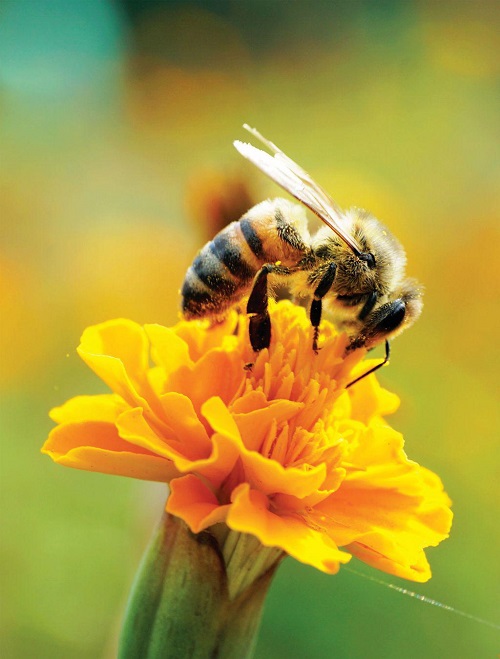
Scientific Name: Nomia melanderi
Appearance: Alkali bees are small and often have a brownish-black color with pale stripes.
Natural Habitat: Near alkaline desert areas.
Sting: Safe for humans and pets.
Alkali bees are incredible survivors. They can live in harsh desert conditions. These bees are vital for pollinating alfalfa, a plant often used as food for animals, and help farms produce healthy crops.
Read about the black and yellow butterfly meaning here
12. Carder Bee
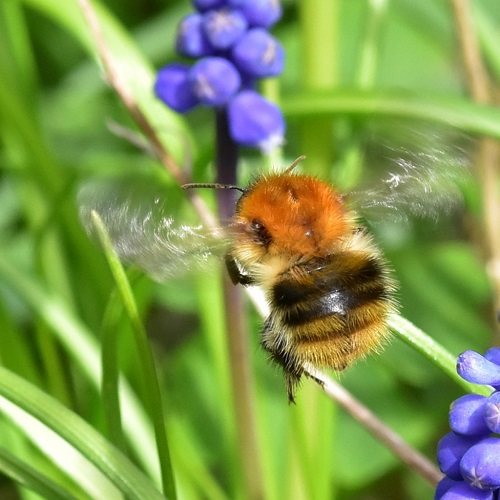
Scientific Name: Bombus pascuorum
Appearance: Carder bees are small and fuzzy, often with yellow, black, or white stripes.
Natural Habitat: They reside in parks and meadows.
Sting: Pose no threat to humans or pets.
Carder bees are skilled builders. They use soft plant fibers to create nests, making them comfortable for their young ones.
13. Squash Bee
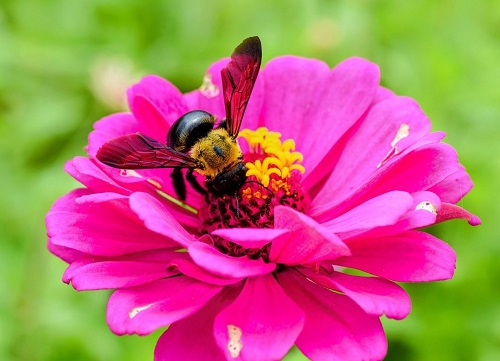
Scientific Name: Peponapis pruinosa
Appearance: Squash bees are medium-sized and have a hairy body with shades of black and orange.
Natural Habitat: Found in fields and gardens where squash plants grow.
Sting: Non-dangerous for pets and people.
Squash bees are squash plant enthusiasts! They are specialists in pollinating squash flowers and are named for helping squash plants produce delicious fruits.
14. Cuckoo Bee
Scientific Name: Nomada fervida
Appearance: Cuckoo bees have various colors and patterns, including brown, yellow, and even neon.
Natural Habitat: You’ll see these in meadows, gardens, and fields.
Sting: No risk to humans or pets. Only sting when provoked.
Cuckoo bees are sneaky tricksters. They lay their eggs in the nests of other bees, letting those bees raise their young. They don’t collect pollen but rely on other bees’ hard work.
Fun Fact: Cuckoo birds also don’t raise their young. They lay their eggs in the nests of other birds. This is why the Cuckoo bee is named after these birds.
15. Masked Bee
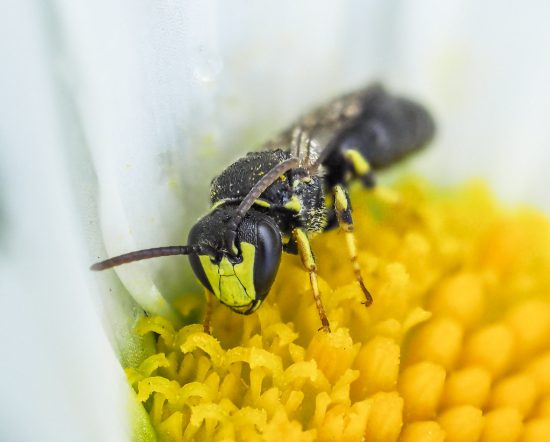
Scientific Name: Hylaeus agilis
Appearance: Masked bees are small, often black, and can have yellow or white markings.
Natural Habitat: Near gardens and coastal areas.
Sting: Harmless to humans and pets. May cause discomfort.
Masked bees are excellent pollinators that often go unnoticed. They build nests in hollow stems and holes. These bees are essential for wildflowers and plants along coastlines, helping them reproduce and thrive.
Look at the moth that are as beautiful as butterflies
16. Green Metallic Sweat Bee
Scientific Name: Augochloropsis metallica
Appearance: Green metallic sweat bees are small and shiny, with bright green or blue-green colors.
Natural Habitat: Located in gardens, meadows, and fields.
Sting: Rarely sting. No danger to humans or pets.
Green metallic sweat bees are as beautiful as jewels! Their vibrant colors make them easy to spot.
17. Sunflower Bee
Scientific Name: Diadasia spp.
Appearance: Sunflower bees are medium-sized and often have a fuzzy body with shades of black and yellow.
Natural Habitat: You’ll spot them wherever sunflowers grow.
Sting: Completely safe for humans and pets.
Sunflower bees are excellent at pollinating sunflowers, ensuring these tall, bright flowers produce seeds. Without them, sunflower fields wouldn’t be as lovely, and we wouldn’t have sunflower seeds for snacks!
18. Polyester Bee
Scientific Name: Colletes spp.
Appearance: Polyester bees are small to medium-sized, often with a dark body and pale stripes.
Natural Habitat: Found near open fields and gardens.
Sting: Stings might hurt for a bit. Presents no harm to humans or pets.
Polyester bees are skilled nest builders. They dig underground tunnels to create cozy homes for their young ones.
19. Giant Resin Bee
Scientific Name: Megachile sculpturalis
Appearance: Resin bees are enormous and often have shiny, dark bodies with pale bands.
Natural Habitat: They thrive in meadows and gardens.
Sting: Non-toxic to humans and pets. You may experience some reactions if you have an allergy.
Resin bees are resourceful builders and are often called tunnel nesters. The name comes from their nesting habitat. They dig narrow nests in crevices and tree cavities.
Fun Fact: Giant Resin Bees were native to Asia but were introduced to the United States later on.
Look at the beautiful black and blue butterflies here
20. Cactus Bee
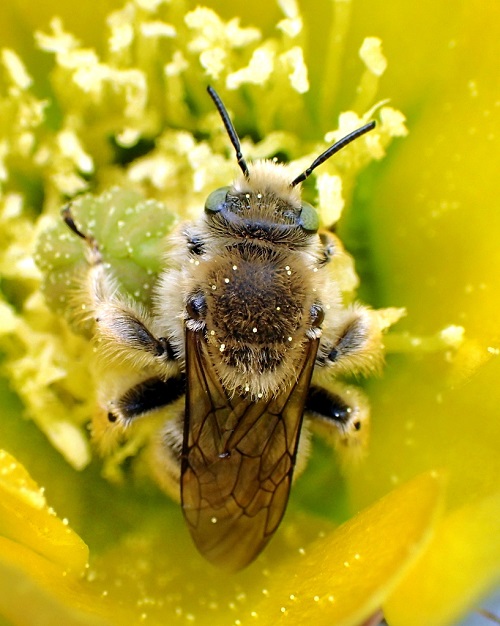
Scientific Name: Diadasia Rinconis
Appearance: Cactus bees are small to medium-sized and have hairy bodies with shades of black, brown, or orange.
Natural Habitat: Found near desert areas where cacti grow.
Sting: Causes mild discomfort. No adverse effects on humans or pets.
Cactus bees are cactus lovers! They are specialized pollinators, helping cacti produce fruits. These bees are essential for desert ecosystems, ensuring cacti thrive and provide food and shelter for various animals.
21. White Tailed Bumblebee
Scientific Name: Bombus lucorum
Appearance: White-tailed bumblebees have a black body and a distinctive white tail.
Natural Habitat: You can easily spot them in your backyard or fields.
Sting: Non-aggressive towards humans or pets. Stings do not cause any permanent harm, just swelling.
White-tailed bumblebees are social bees, living in colonies and working together to support their hive.
22. Red Tailed Bumblebee
Scientific Name: Bombus lapidaries
Appearance: Red-tailed bumblebees have black bodies with a bright red tail.
Natural Habitat: Spotted in grassy areas and meadows.
Sting: Temporary pain from the sting. Completely benign for humans and pets.
Red-tailed bumblebees are easily recognizable by their striking red tails. They love to nest under stones.
Want to know do leafcutter bees sting? Find the answer here
What to Do When a Bee Stings You?
Bee Stings are rarely fatal. There’s no need to panic if you get stung. First, move away from the bee to avoid more stings. Gently remove the stinger from your skin with something flat, like a credit card.
Wash the area and clean it properly with soap. You can put an ice pack on the sting for about 15 minutes to keep the swelling under control. Sometimes, a little honey or paste from baking soda and water can help soothe the sting.
You should keep an eye out for any allergic reactions or severe symptoms. If you have trouble breathing or feel extreme discomfort, call 911.
How are Bees Different from Wasps?
Bees and wasps are both flying insects, but they have some important differences.
Diet
- Bees: Collect nectar and pollen from flowers to make honey; fuzzy bodies help them collect pollen.
- Wasps: Eat other insects; have smooth bodies and are usually shiny.
Behavior
- Bees: Busy and mostly don’t bother people unless threatened.
- Wasps: They can be aggressive and might sting even if not provoked.
Roles in Nature
- Bees: Act like gardeners, helping flowers grow by pollinating them.
- Wasps: Act like hunters, preying on other insects for food.
Physical Differences
- Bees: Fuzzy bodies, often more robust.
- Wasps: Smooth bodies, usually slender and shiny.
Now that you know everything about all the different types of bees, you should try and look for as many bee types as you can.



